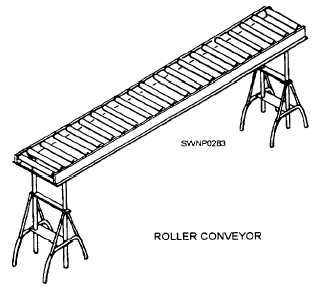Timber skids (planks) are placed longitudinally under heavy loads to distribute the weight over a greater area. (See fig. 6-35.) The angle of the skids must be kept low to prevent the load from drifting or getting out of control. Skids can be greased only when horizontal movement is involved. Extreme care must be exercised. In most circumstances greasing is inherently dangerous, as it can cause the load to drift sideways suddenly, causing injuries to personnel and damage to equipment.
Hardwood or pipe rollers can be used in conjunction with plank skids for moving heavy loads into position. Planks are placed under the rollers to provide a smooth continuous surface to enable them to roll easily. The rollers must be smooth and round to aid in the ease of movement and long enough to pass completely under the load. The load should be supported by longitudinal wooden members to provide a smooth upper surface for the rollers to roll on. The skids placed underneath must form continuous support. Normal practice is to place four to six rollers under the load to be moved. Several rollers are to be placed in front of the load and the load is then slowly rolled onto these rollers. As the load passes the rollers that are left clear of the load they are then picked up and moved in front of the load. This creates a continuous path of rollers. Turns can be made using rollers; but, first the front rollers must be inclined slightly in the direction of the turn and the rear of the rollers in the opposite direction. This inclination of the rollers can be made by striking them sharply with a sledge hammer. Rollers can be fabricated and set on axles in side beams as a semipermanent conveyor for lighter loads. Permanent metal roller conveyors are available (fig. 6-36) and are normally fabricated in sections which can be joined together.
BLOCKING AND CRIBBING
Block timbers are commonly used to provide a foundation for heavy loads or jacks. Cribbing must be used when a heavy weight must be supported at a height greater than blocking can provide. Cribbing is made up by aligning timber in tiers that run in alternate directions (fig. 6-37). Blocking and cribbing is often necessary as a safety measure to keep an object stationary to prevent accidents and injury to personnel working near these heavy objects.
When selecting blocking as a foundation for jacks, ensure it is sound and large enough to support the load safely. It must be free from grease and thoroughly dry.

Figure 6-36. - Permanent metal roller conveyor.

Figure 6-37. - Examples of the use of cribbing.
Additionally, it must be placed firmly on the ground with the load (pressure) distributed evenly.
A firm and level foundation is a paramount requirement where cribbing is used. Also, equally as
Continue Reading